Organisation and Behaviour Report: Leadership and Motivation in CAPCO
VerifiedAdded on 2019/12/04
|23
|7102
|351
Report
AI Summary
This report provides a comprehensive analysis of organizational behavior, focusing on leadership styles, organizational culture, and motivation theories. It contrasts and compares the organizational structures and cultures of CAPCO and HSBC, highlighting the influence of these factors on individual and group behavior. The report delves into the effectiveness of different leadership styles, such as autocratic, democratic, and laissez-faire, within these companies. It also explores how organizational theories impact management practices and evaluates the approaches used by CAPCO and HSBC. Furthermore, the report discusses the impact of leadership styles on motivation during periods of change, examines motivational theories within CAPCO, and emphasizes the importance of managers understanding and applying these theories. The report also covers the nature of groups and group behavior, factors promoting effective teamwork, and the impact of technology on team functioning within CAPCO, offering valuable insights into organizational dynamics.
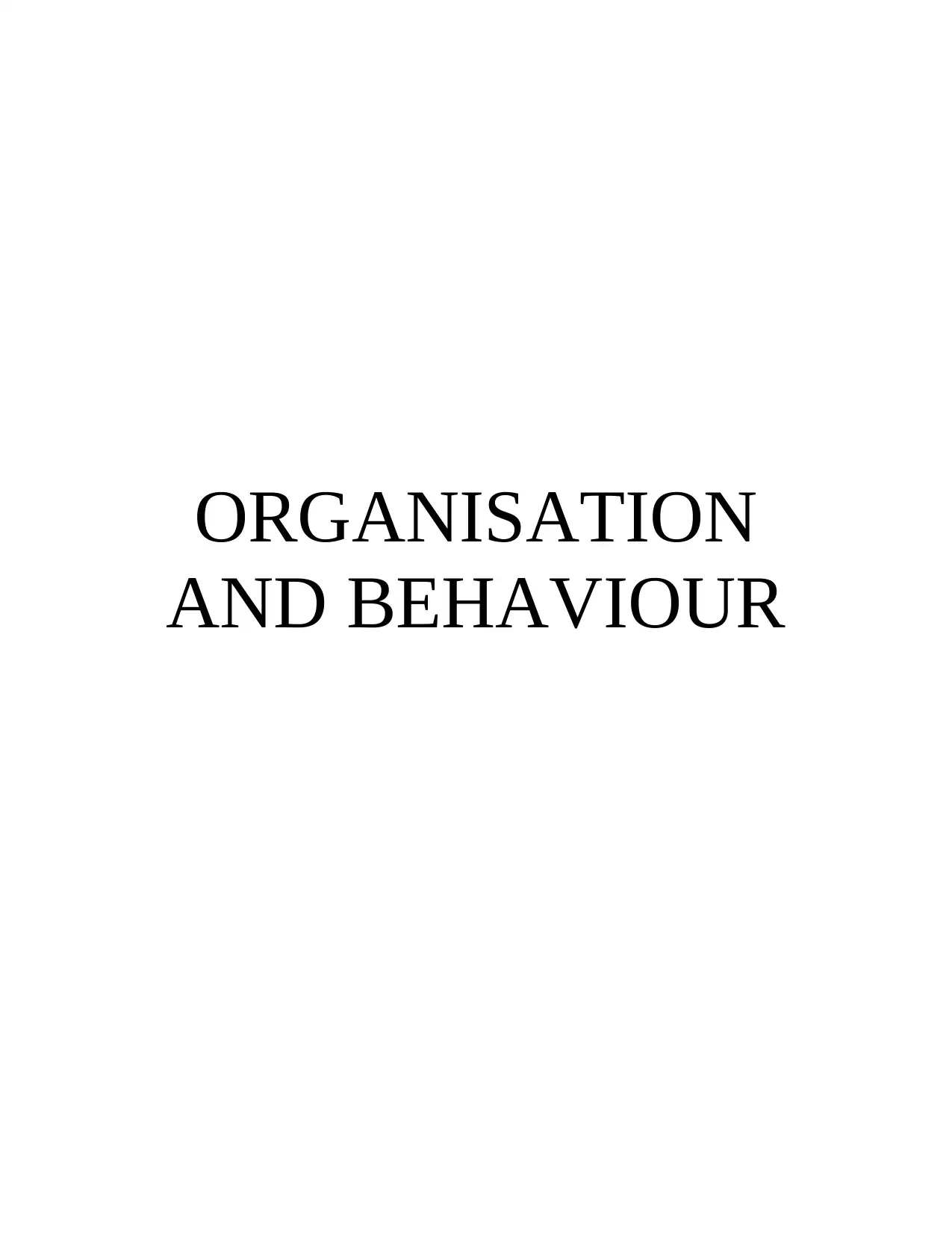
ORGANISATION
AND BEHAVIOUR
AND BEHAVIOUR
Paraphrase This Document
Need a fresh take? Get an instant paraphrase of this document with our AI Paraphraser
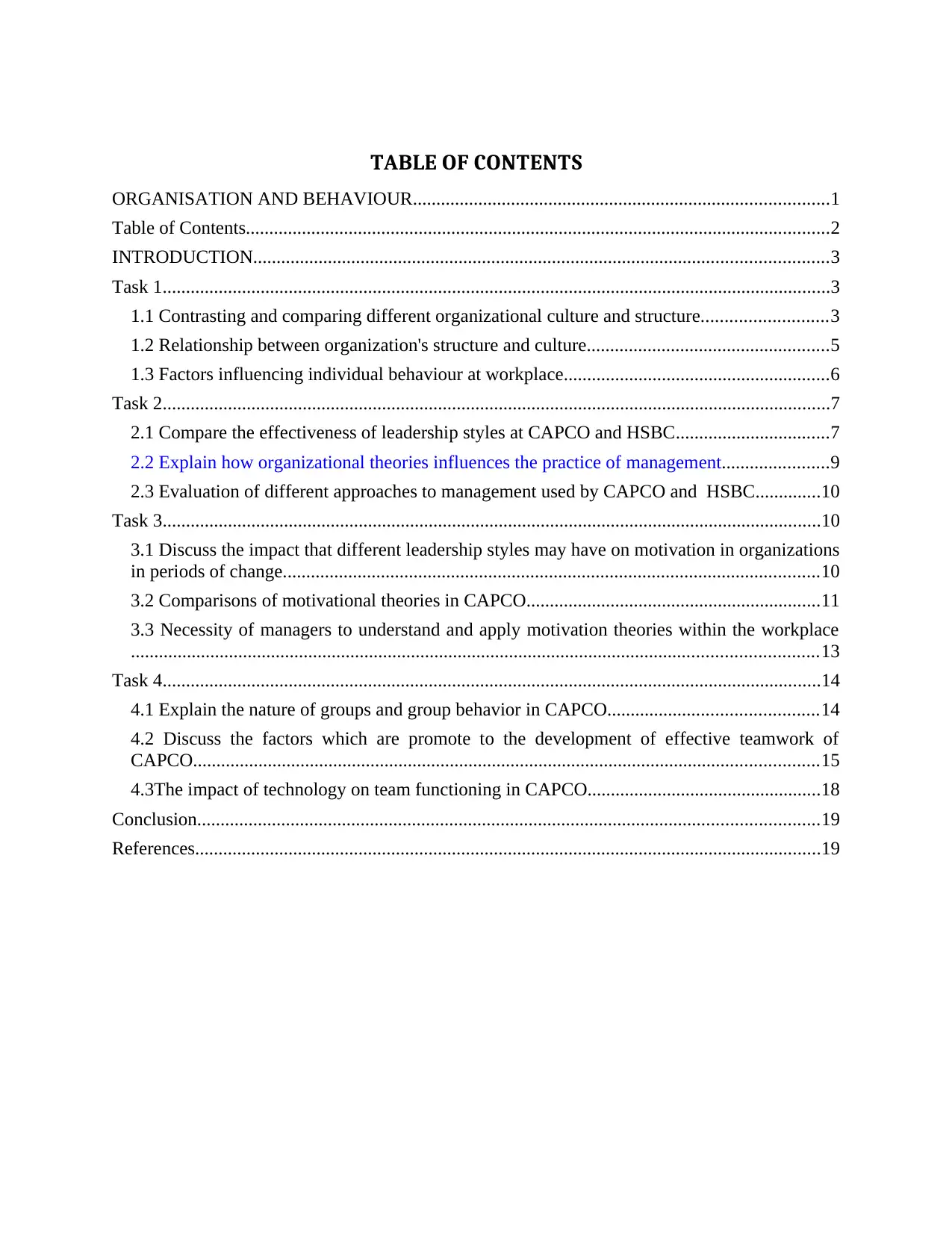
TABLE OF CONTENTS
ORGANISATION AND BEHAVIOUR.........................................................................................1
Table of Contents.............................................................................................................................2
INTRODUCTION...........................................................................................................................3
Task 1...............................................................................................................................................3
1.1 Contrasting and comparing different organizational culture and structure...........................3
1.2 Relationship between organization's structure and culture....................................................5
1.3 Factors influencing individual behaviour at workplace.........................................................6
Task 2...............................................................................................................................................7
2.1 Compare the effectiveness of leadership styles at CAPCO and HSBC.................................7
2.2 Explain how organizational theories influences the practice of management.......................9
2.3 Evaluation of different approaches to management used by CAPCO and HSBC..............10
Task 3.............................................................................................................................................10
3.1 Discuss the impact that different leadership styles may have on motivation in organizations
in periods of change...................................................................................................................10
3.2 Comparisons of motivational theories in CAPCO...............................................................11
3.3 Necessity of managers to understand and apply motivation theories within the workplace
...................................................................................................................................................13
Task 4.............................................................................................................................................14
4.1 Explain the nature of groups and group behavior in CAPCO.............................................14
4.2 Discuss the factors which are promote to the development of effective teamwork of
CAPCO......................................................................................................................................15
4.3The impact of technology on team functioning in CAPCO..................................................18
Conclusion.....................................................................................................................................19
References......................................................................................................................................19
ORGANISATION AND BEHAVIOUR.........................................................................................1
Table of Contents.............................................................................................................................2
INTRODUCTION...........................................................................................................................3
Task 1...............................................................................................................................................3
1.1 Contrasting and comparing different organizational culture and structure...........................3
1.2 Relationship between organization's structure and culture....................................................5
1.3 Factors influencing individual behaviour at workplace.........................................................6
Task 2...............................................................................................................................................7
2.1 Compare the effectiveness of leadership styles at CAPCO and HSBC.................................7
2.2 Explain how organizational theories influences the practice of management.......................9
2.3 Evaluation of different approaches to management used by CAPCO and HSBC..............10
Task 3.............................................................................................................................................10
3.1 Discuss the impact that different leadership styles may have on motivation in organizations
in periods of change...................................................................................................................10
3.2 Comparisons of motivational theories in CAPCO...............................................................11
3.3 Necessity of managers to understand and apply motivation theories within the workplace
...................................................................................................................................................13
Task 4.............................................................................................................................................14
4.1 Explain the nature of groups and group behavior in CAPCO.............................................14
4.2 Discuss the factors which are promote to the development of effective teamwork of
CAPCO......................................................................................................................................15
4.3The impact of technology on team functioning in CAPCO..................................................18
Conclusion.....................................................................................................................................19
References......................................................................................................................................19
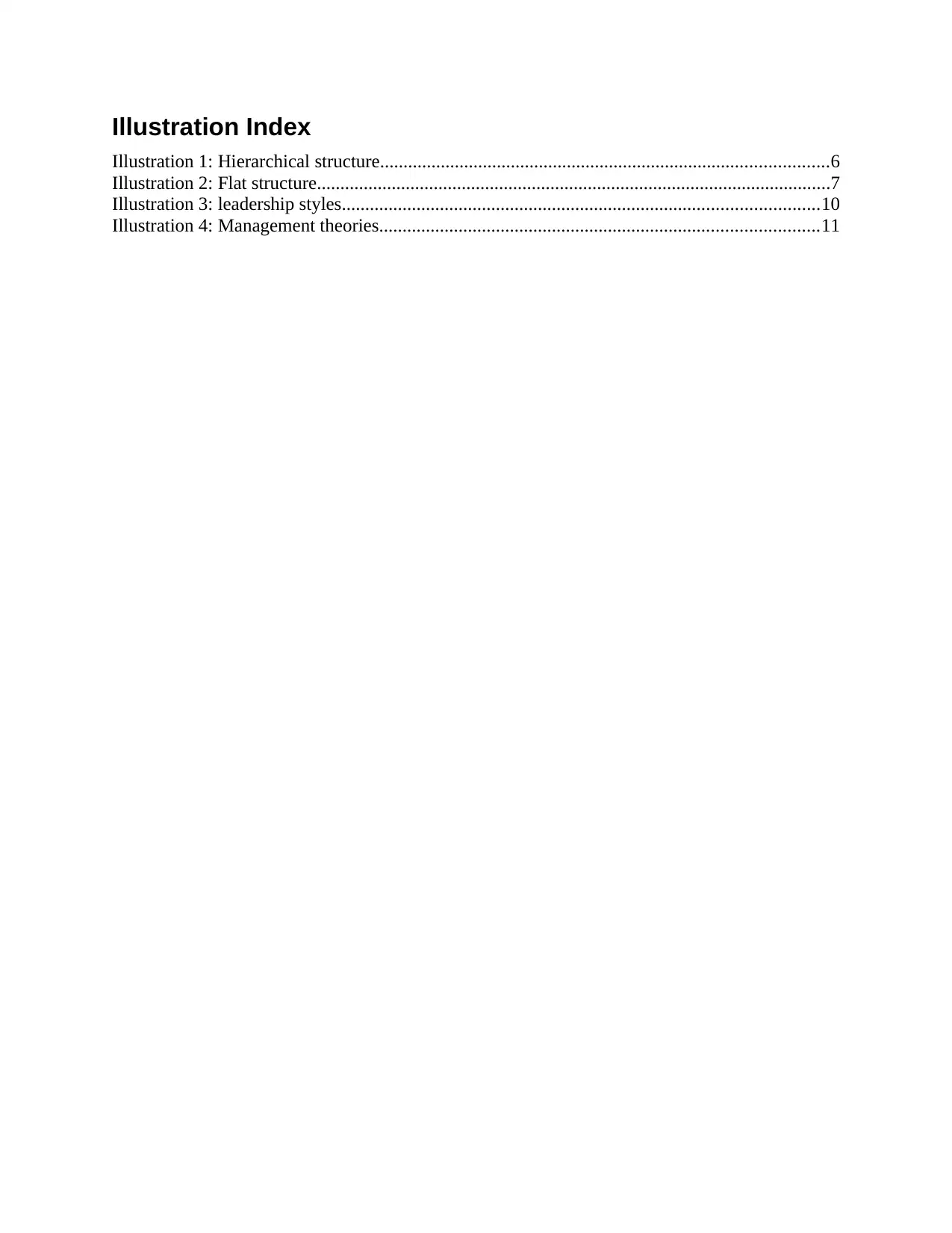
Illustration Index
Illustration 1: Hierarchical structure................................................................................................6
Illustration 2: Flat structure..............................................................................................................7
Illustration 3: leadership styles......................................................................................................10
Illustration 4: Management theories..............................................................................................11
Illustration 1: Hierarchical structure................................................................................................6
Illustration 2: Flat structure..............................................................................................................7
Illustration 3: leadership styles......................................................................................................10
Illustration 4: Management theories..............................................................................................11
⊘ This is a preview!⊘
Do you want full access?
Subscribe today to unlock all pages.

Trusted by 1+ million students worldwide
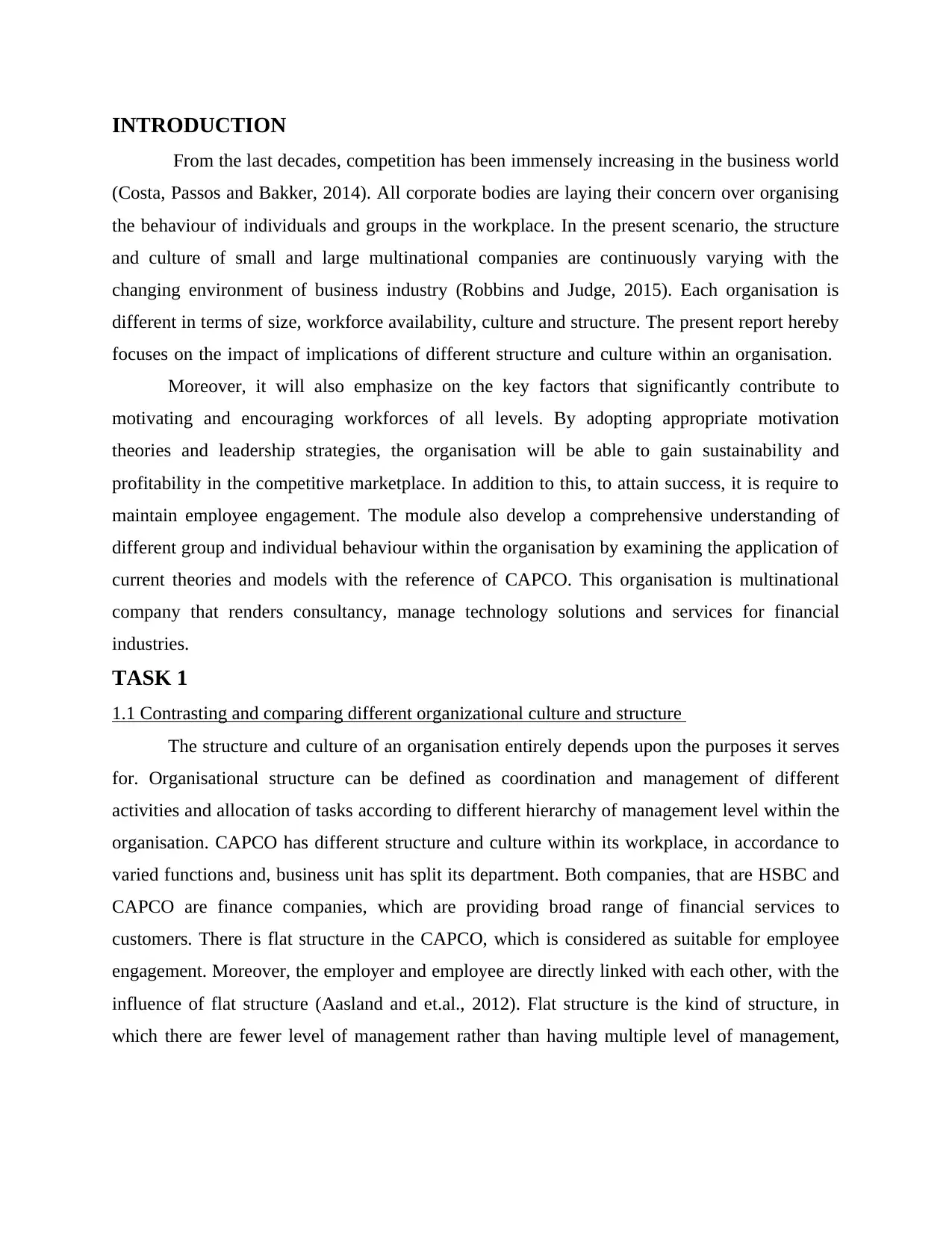
INTRODUCTION
From the last decades, competition has been immensely increasing in the business world
(Costa, Passos and Bakker, 2014). All corporate bodies are laying their concern over organising
the behaviour of individuals and groups in the workplace. In the present scenario, the structure
and culture of small and large multinational companies are continuously varying with the
changing environment of business industry (Robbins and Judge, 2015). Each organisation is
different in terms of size, workforce availability, culture and structure. The present report hereby
focuses on the impact of implications of different structure and culture within an organisation.
Moreover, it will also emphasize on the key factors that significantly contribute to
motivating and encouraging workforces of all levels. By adopting appropriate motivation
theories and leadership strategies, the organisation will be able to gain sustainability and
profitability in the competitive marketplace. In addition to this, to attain success, it is require to
maintain employee engagement. The module also develop a comprehensive understanding of
different group and individual behaviour within the organisation by examining the application of
current theories and models with the reference of CAPCO. This organisation is multinational
company that renders consultancy, manage technology solutions and services for financial
industries.
TASK 1
1.1 Contrasting and comparing different organizational culture and structure
The structure and culture of an organisation entirely depends upon the purposes it serves
for. Organisational structure can be defined as coordination and management of different
activities and allocation of tasks according to different hierarchy of management level within the
organisation. CAPCO has different structure and culture within its workplace, in accordance to
varied functions and, business unit has split its department. Both companies, that are HSBC and
CAPCO are finance companies, which are providing broad range of financial services to
customers. There is flat structure in the CAPCO, which is considered as suitable for employee
engagement. Moreover, the employer and employee are directly linked with each other, with the
influence of flat structure (Aasland and et.al., 2012). Flat structure is the kind of structure, in
which there are fewer level of management rather than having multiple level of management,
From the last decades, competition has been immensely increasing in the business world
(Costa, Passos and Bakker, 2014). All corporate bodies are laying their concern over organising
the behaviour of individuals and groups in the workplace. In the present scenario, the structure
and culture of small and large multinational companies are continuously varying with the
changing environment of business industry (Robbins and Judge, 2015). Each organisation is
different in terms of size, workforce availability, culture and structure. The present report hereby
focuses on the impact of implications of different structure and culture within an organisation.
Moreover, it will also emphasize on the key factors that significantly contribute to
motivating and encouraging workforces of all levels. By adopting appropriate motivation
theories and leadership strategies, the organisation will be able to gain sustainability and
profitability in the competitive marketplace. In addition to this, to attain success, it is require to
maintain employee engagement. The module also develop a comprehensive understanding of
different group and individual behaviour within the organisation by examining the application of
current theories and models with the reference of CAPCO. This organisation is multinational
company that renders consultancy, manage technology solutions and services for financial
industries.
TASK 1
1.1 Contrasting and comparing different organizational culture and structure
The structure and culture of an organisation entirely depends upon the purposes it serves
for. Organisational structure can be defined as coordination and management of different
activities and allocation of tasks according to different hierarchy of management level within the
organisation. CAPCO has different structure and culture within its workplace, in accordance to
varied functions and, business unit has split its department. Both companies, that are HSBC and
CAPCO are finance companies, which are providing broad range of financial services to
customers. There is flat structure in the CAPCO, which is considered as suitable for employee
engagement. Moreover, the employer and employee are directly linked with each other, with the
influence of flat structure (Aasland and et.al., 2012). Flat structure is the kind of structure, in
which there are fewer level of management rather than having multiple level of management,
Paraphrase This Document
Need a fresh take? Get an instant paraphrase of this document with our AI Paraphraser
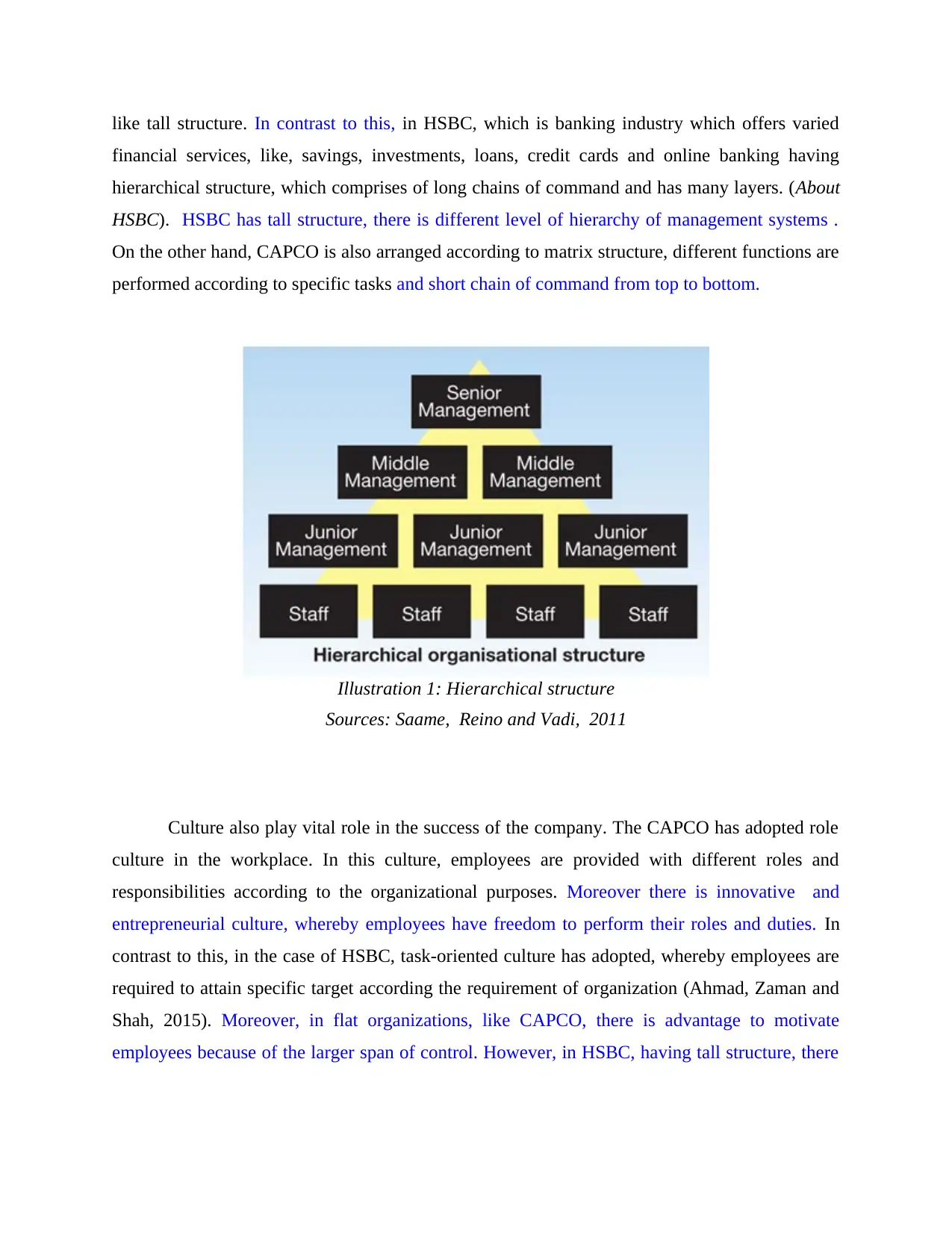
like tall structure. In contrast to this, in HSBC, which is banking industry which offers varied
financial services, like, savings, investments, loans, credit cards and online banking having
hierarchical structure, which comprises of long chains of command and has many layers. (About
HSBC). HSBC has tall structure, there is different level of hierarchy of management systems .
On the other hand, CAPCO is also arranged according to matrix structure, different functions are
performed according to specific tasks and short chain of command from top to bottom.
Culture also play vital role in the success of the company. The CAPCO has adopted role
culture in the workplace. In this culture, employees are provided with different roles and
responsibilities according to the organizational purposes. Moreover there is innovative and
entrepreneurial culture, whereby employees have freedom to perform their roles and duties. In
contrast to this, in the case of HSBC, task-oriented culture has adopted, whereby employees are
required to attain specific target according the requirement of organization (Ahmad, Zaman and
Shah, 2015). Moreover, in flat organizations, like CAPCO, there is advantage to motivate
employees because of the larger span of control. However, in HSBC, having tall structure, there
Illustration 1: Hierarchical structure
Sources: Saame, Reino and Vadi, 2011
financial services, like, savings, investments, loans, credit cards and online banking having
hierarchical structure, which comprises of long chains of command and has many layers. (About
HSBC). HSBC has tall structure, there is different level of hierarchy of management systems .
On the other hand, CAPCO is also arranged according to matrix structure, different functions are
performed according to specific tasks and short chain of command from top to bottom.
Culture also play vital role in the success of the company. The CAPCO has adopted role
culture in the workplace. In this culture, employees are provided with different roles and
responsibilities according to the organizational purposes. Moreover there is innovative and
entrepreneurial culture, whereby employees have freedom to perform their roles and duties. In
contrast to this, in the case of HSBC, task-oriented culture has adopted, whereby employees are
required to attain specific target according the requirement of organization (Ahmad, Zaman and
Shah, 2015). Moreover, in flat organizations, like CAPCO, there is advantage to motivate
employees because of the larger span of control. However, in HSBC, having tall structure, there
Illustration 1: Hierarchical structure
Sources: Saame, Reino and Vadi, 2011
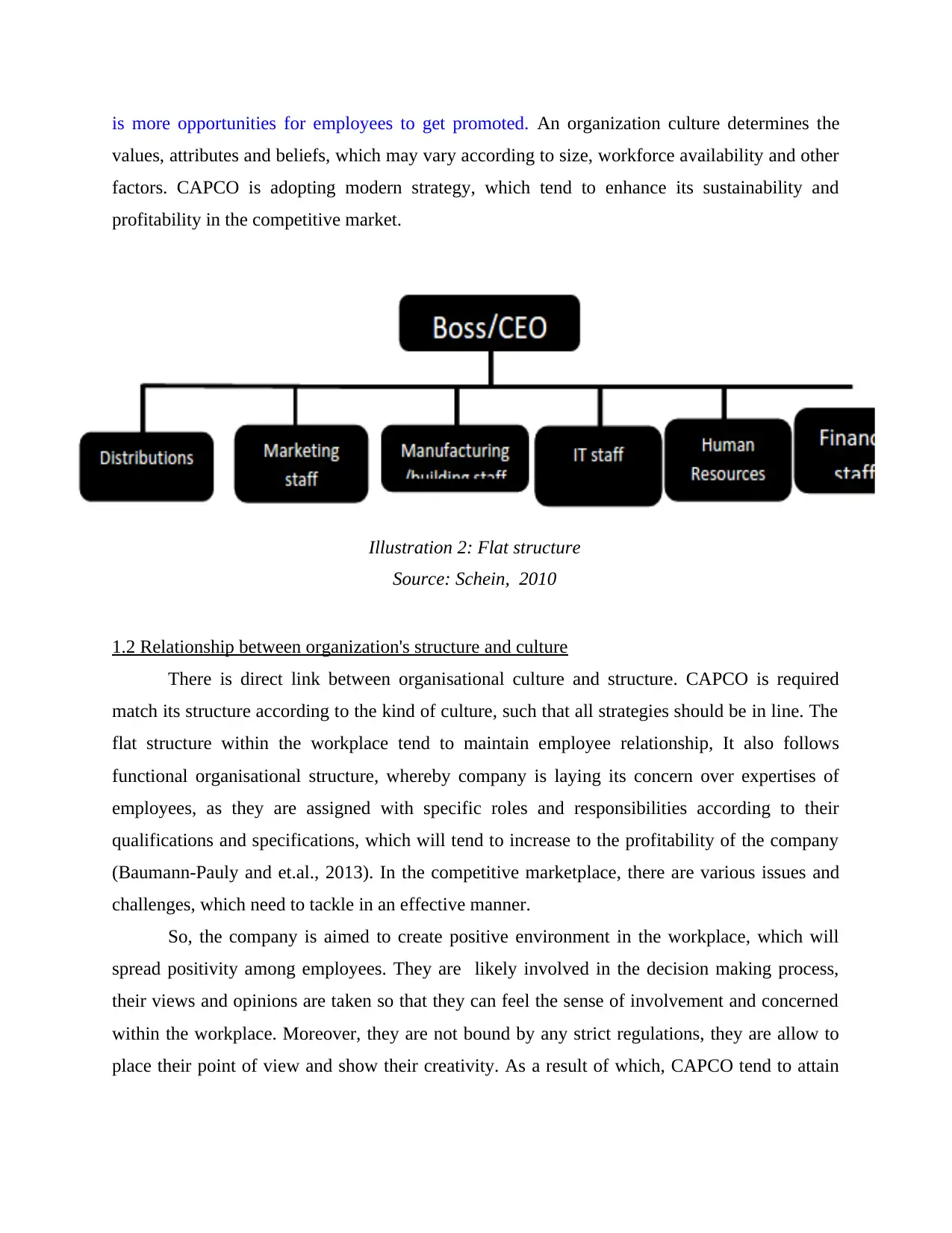
is more opportunities for employees to get promoted. An organization culture determines the
values, attributes and beliefs, which may vary according to size, workforce availability and other
factors. CAPCO is adopting modern strategy, which tend to enhance its sustainability and
profitability in the competitive market.
1.2 Relationship between organization's structure and culture
There is direct link between organisational culture and structure. CAPCO is required
match its structure according to the kind of culture, such that all strategies should be in line. The
flat structure within the workplace tend to maintain employee relationship, It also follows
functional organisational structure, whereby company is laying its concern over expertises of
employees, as they are assigned with specific roles and responsibilities according to their
qualifications and specifications, which will tend to increase to the profitability of the company
(Baumann-Pauly and et.al., 2013). In the competitive marketplace, there are various issues and
challenges, which need to tackle in an effective manner.
So, the company is aimed to create positive environment in the workplace, which will
spread positivity among employees. They are likely involved in the decision making process,
their views and opinions are taken so that they can feel the sense of involvement and concerned
within the workplace. Moreover, they are not bound by any strict regulations, they are allow to
place their point of view and show their creativity. As a result of which, CAPCO tend to attain
Illustration 2: Flat structure
Source: Schein, 2010
values, attributes and beliefs, which may vary according to size, workforce availability and other
factors. CAPCO is adopting modern strategy, which tend to enhance its sustainability and
profitability in the competitive market.
1.2 Relationship between organization's structure and culture
There is direct link between organisational culture and structure. CAPCO is required
match its structure according to the kind of culture, such that all strategies should be in line. The
flat structure within the workplace tend to maintain employee relationship, It also follows
functional organisational structure, whereby company is laying its concern over expertises of
employees, as they are assigned with specific roles and responsibilities according to their
qualifications and specifications, which will tend to increase to the profitability of the company
(Baumann-Pauly and et.al., 2013). In the competitive marketplace, there are various issues and
challenges, which need to tackle in an effective manner.
So, the company is aimed to create positive environment in the workplace, which will
spread positivity among employees. They are likely involved in the decision making process,
their views and opinions are taken so that they can feel the sense of involvement and concerned
within the workplace. Moreover, they are not bound by any strict regulations, they are allow to
place their point of view and show their creativity. As a result of which, CAPCO tend to attain
Illustration 2: Flat structure
Source: Schein, 2010
⊘ This is a preview!⊘
Do you want full access?
Subscribe today to unlock all pages.

Trusted by 1+ million students worldwide
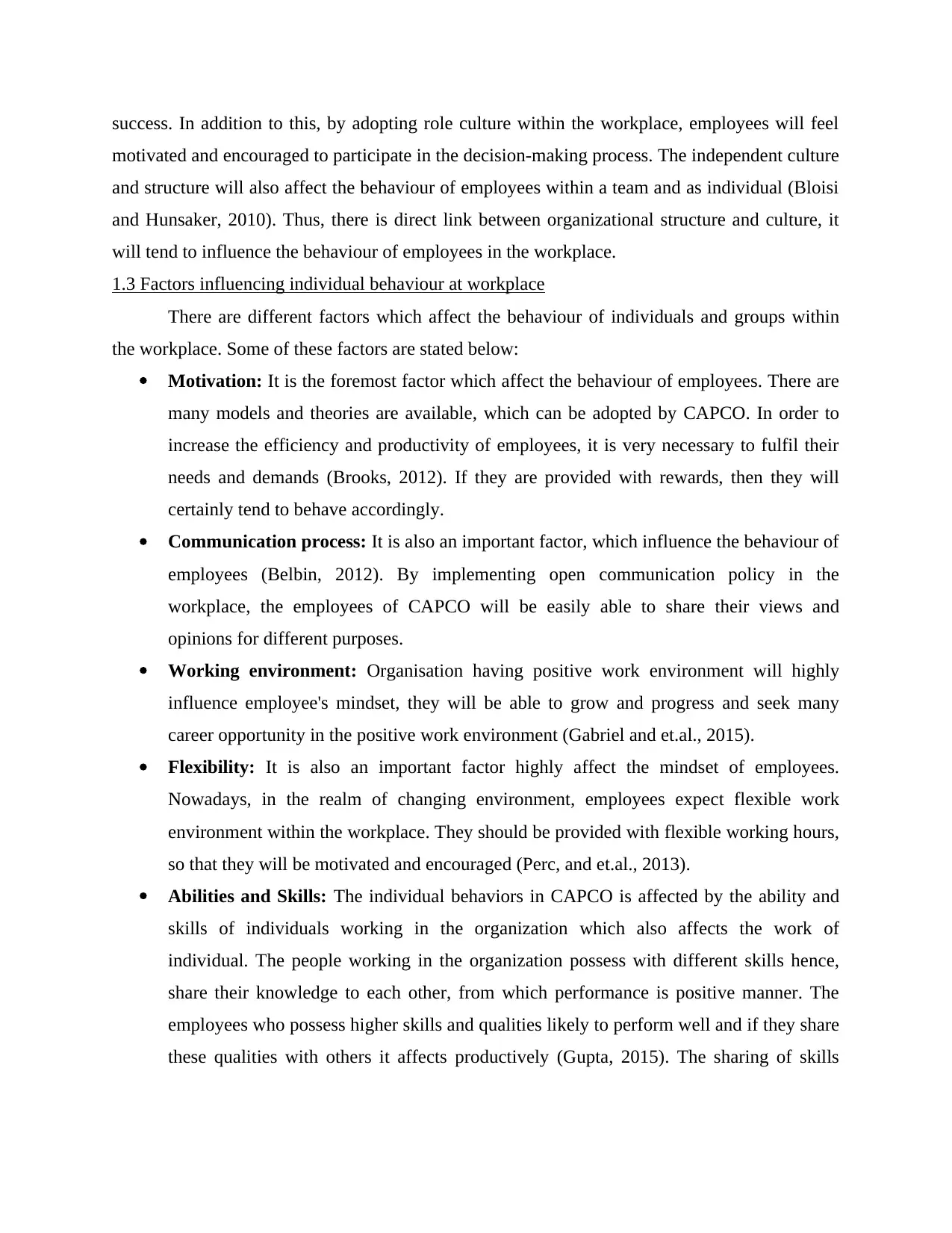
success. In addition to this, by adopting role culture within the workplace, employees will feel
motivated and encouraged to participate in the decision-making process. The independent culture
and structure will also affect the behaviour of employees within a team and as individual (Bloisi
and Hunsaker, 2010). Thus, there is direct link between organizational structure and culture, it
will tend to influence the behaviour of employees in the workplace.
1.3 Factors influencing individual behaviour at workplace
There are different factors which affect the behaviour of individuals and groups within
the workplace. Some of these factors are stated below:
Motivation: It is the foremost factor which affect the behaviour of employees. There are
many models and theories are available, which can be adopted by CAPCO. In order to
increase the efficiency and productivity of employees, it is very necessary to fulfil their
needs and demands (Brooks, 2012). If they are provided with rewards, then they will
certainly tend to behave accordingly.
Communication process: It is also an important factor, which influence the behaviour of
employees (Belbin, 2012). By implementing open communication policy in the
workplace, the employees of CAPCO will be easily able to share their views and
opinions for different purposes.
Working environment: Organisation having positive work environment will highly
influence employee's mindset, they will be able to grow and progress and seek many
career opportunity in the positive work environment (Gabriel and et.al., 2015).
Flexibility: It is also an important factor highly affect the mindset of employees.
Nowadays, in the realm of changing environment, employees expect flexible work
environment within the workplace. They should be provided with flexible working hours,
so that they will be motivated and encouraged (Perc, and et.al., 2013).
Abilities and Skills: The individual behaviors in CAPCO is affected by the ability and
skills of individuals working in the organization which also affects the work of
individual. The people working in the organization possess with different skills hence,
share their knowledge to each other, from which performance is positive manner. The
employees who possess higher skills and qualities likely to perform well and if they share
these qualities with others it affects productively (Gupta, 2015). The sharing of skills
motivated and encouraged to participate in the decision-making process. The independent culture
and structure will also affect the behaviour of employees within a team and as individual (Bloisi
and Hunsaker, 2010). Thus, there is direct link between organizational structure and culture, it
will tend to influence the behaviour of employees in the workplace.
1.3 Factors influencing individual behaviour at workplace
There are different factors which affect the behaviour of individuals and groups within
the workplace. Some of these factors are stated below:
Motivation: It is the foremost factor which affect the behaviour of employees. There are
many models and theories are available, which can be adopted by CAPCO. In order to
increase the efficiency and productivity of employees, it is very necessary to fulfil their
needs and demands (Brooks, 2012). If they are provided with rewards, then they will
certainly tend to behave accordingly.
Communication process: It is also an important factor, which influence the behaviour of
employees (Belbin, 2012). By implementing open communication policy in the
workplace, the employees of CAPCO will be easily able to share their views and
opinions for different purposes.
Working environment: Organisation having positive work environment will highly
influence employee's mindset, they will be able to grow and progress and seek many
career opportunity in the positive work environment (Gabriel and et.al., 2015).
Flexibility: It is also an important factor highly affect the mindset of employees.
Nowadays, in the realm of changing environment, employees expect flexible work
environment within the workplace. They should be provided with flexible working hours,
so that they will be motivated and encouraged (Perc, and et.al., 2013).
Abilities and Skills: The individual behaviors in CAPCO is affected by the ability and
skills of individuals working in the organization which also affects the work of
individual. The people working in the organization possess with different skills hence,
share their knowledge to each other, from which performance is positive manner. The
employees who possess higher skills and qualities likely to perform well and if they share
these qualities with others it affects productively (Gupta, 2015). The sharing of skills
Paraphrase This Document
Need a fresh take? Get an instant paraphrase of this document with our AI Paraphraser
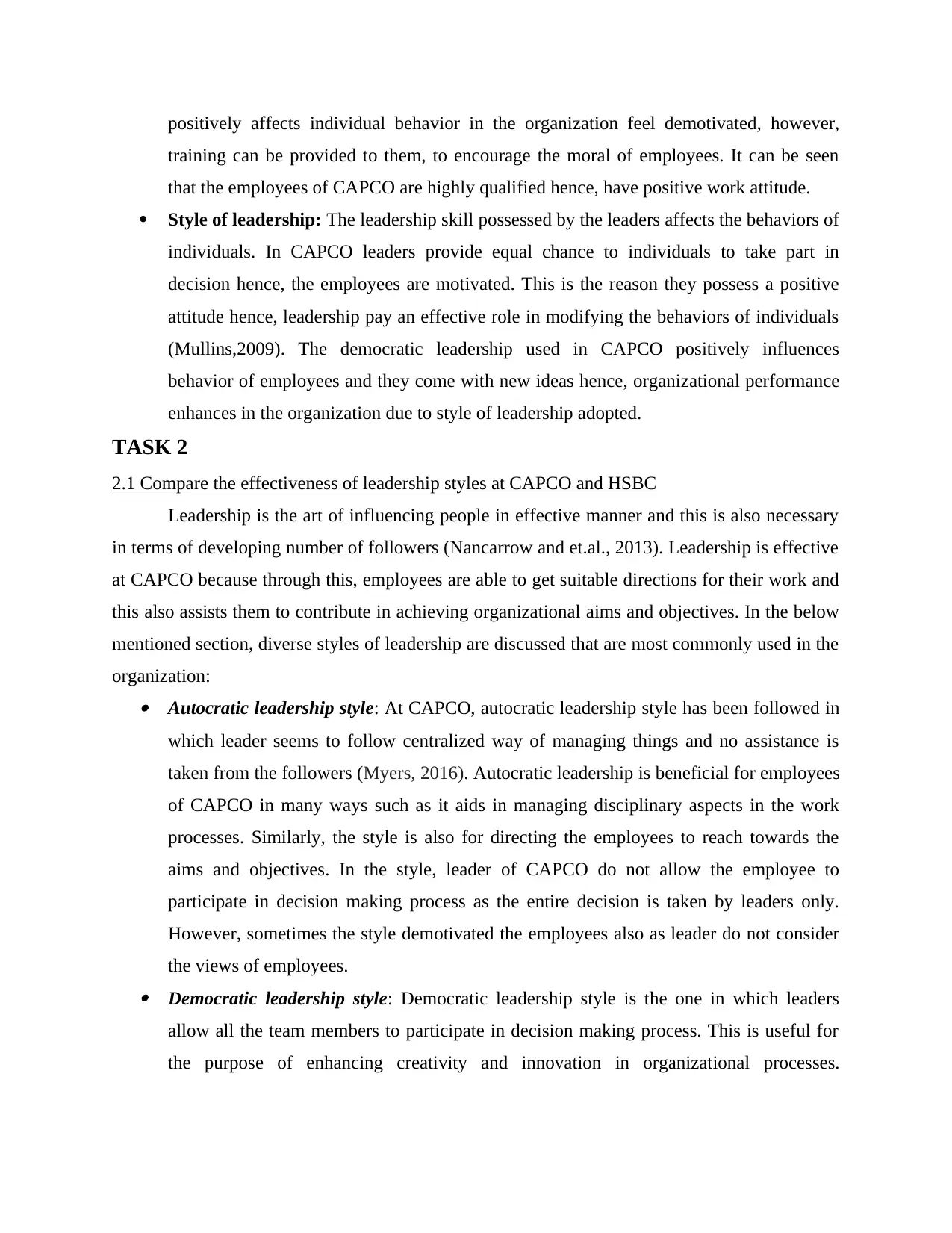
positively affects individual behavior in the organization feel demotivated, however,
training can be provided to them, to encourage the moral of employees. It can be seen
that the employees of CAPCO are highly qualified hence, have positive work attitude.
Style of leadership: The leadership skill possessed by the leaders affects the behaviors of
individuals. In CAPCO leaders provide equal chance to individuals to take part in
decision hence, the employees are motivated. This is the reason they possess a positive
attitude hence, leadership pay an effective role in modifying the behaviors of individuals
(Mullins,2009). The democratic leadership used in CAPCO positively influences
behavior of employees and they come with new ideas hence, organizational performance
enhances in the organization due to style of leadership adopted.
TASK 2
2.1 Compare the effectiveness of leadership styles at CAPCO and HSBC
Leadership is the art of influencing people in effective manner and this is also necessary
in terms of developing number of followers (Nancarrow and et.al., 2013). Leadership is effective
at CAPCO because through this, employees are able to get suitable directions for their work and
this also assists them to contribute in achieving organizational aims and objectives. In the below
mentioned section, diverse styles of leadership are discussed that are most commonly used in the
organization: Autocratic leadership style: At CAPCO, autocratic leadership style has been followed in
which leader seems to follow centralized way of managing things and no assistance is
taken from the followers (Myers, 2016). Autocratic leadership is beneficial for employees
of CAPCO in many ways such as it aids in managing disciplinary aspects in the work
processes. Similarly, the style is also for directing the employees to reach towards the
aims and objectives. In the style, leader of CAPCO do not allow the employee to
participate in decision making process as the entire decision is taken by leaders only.
However, sometimes the style demotivated the employees also as leader do not consider
the views of employees. Democratic leadership style: Democratic leadership style is the one in which leaders
allow all the team members to participate in decision making process. This is useful for
the purpose of enhancing creativity and innovation in organizational processes.
training can be provided to them, to encourage the moral of employees. It can be seen
that the employees of CAPCO are highly qualified hence, have positive work attitude.
Style of leadership: The leadership skill possessed by the leaders affects the behaviors of
individuals. In CAPCO leaders provide equal chance to individuals to take part in
decision hence, the employees are motivated. This is the reason they possess a positive
attitude hence, leadership pay an effective role in modifying the behaviors of individuals
(Mullins,2009). The democratic leadership used in CAPCO positively influences
behavior of employees and they come with new ideas hence, organizational performance
enhances in the organization due to style of leadership adopted.
TASK 2
2.1 Compare the effectiveness of leadership styles at CAPCO and HSBC
Leadership is the art of influencing people in effective manner and this is also necessary
in terms of developing number of followers (Nancarrow and et.al., 2013). Leadership is effective
at CAPCO because through this, employees are able to get suitable directions for their work and
this also assists them to contribute in achieving organizational aims and objectives. In the below
mentioned section, diverse styles of leadership are discussed that are most commonly used in the
organization: Autocratic leadership style: At CAPCO, autocratic leadership style has been followed in
which leader seems to follow centralized way of managing things and no assistance is
taken from the followers (Myers, 2016). Autocratic leadership is beneficial for employees
of CAPCO in many ways such as it aids in managing disciplinary aspects in the work
processes. Similarly, the style is also for directing the employees to reach towards the
aims and objectives. In the style, leader of CAPCO do not allow the employee to
participate in decision making process as the entire decision is taken by leaders only.
However, sometimes the style demotivated the employees also as leader do not consider
the views of employees. Democratic leadership style: Democratic leadership style is the one in which leaders
allow all the team members to participate in decision making process. This is useful for
the purpose of enhancing creativity and innovation in organizational processes.
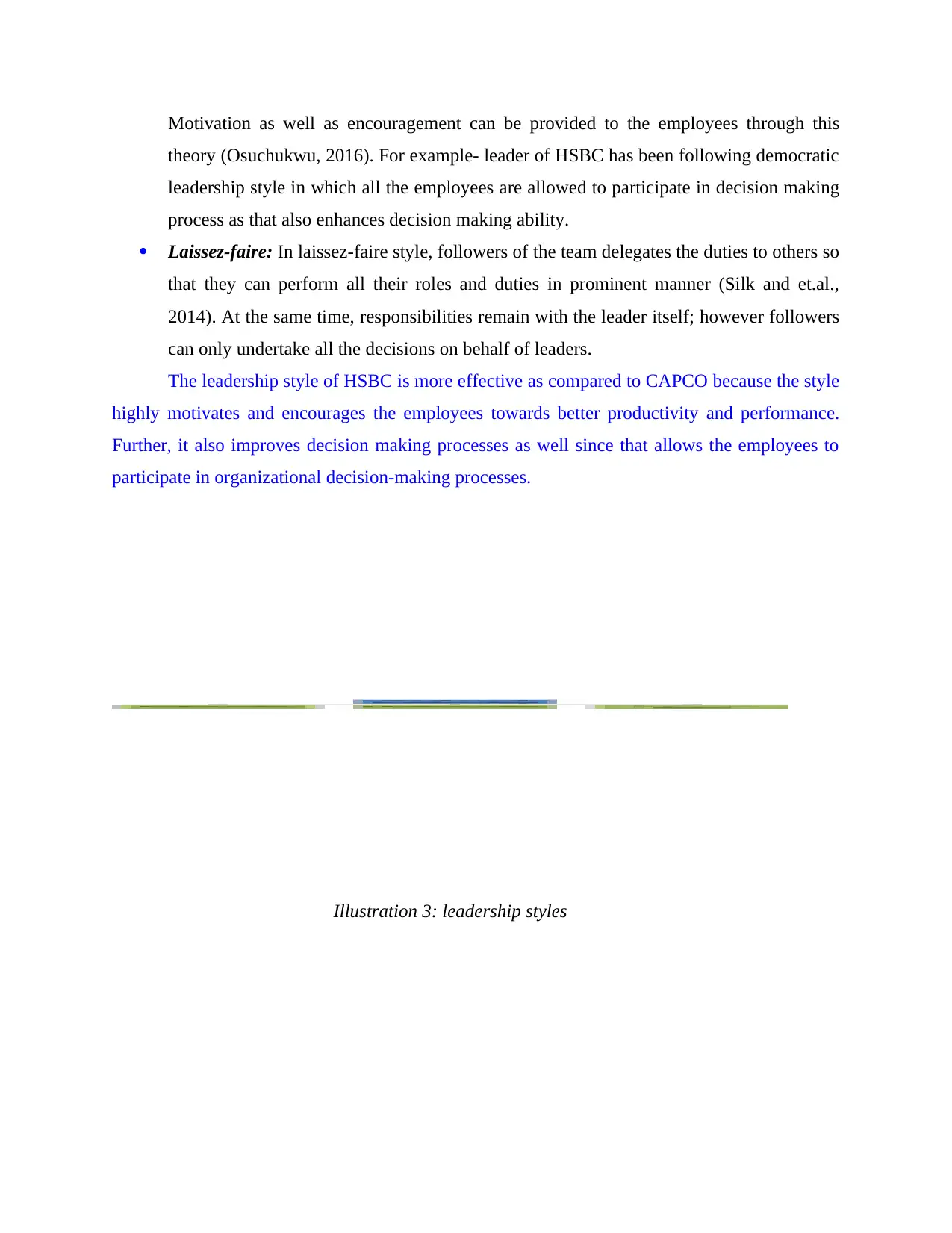
Motivation as well as encouragement can be provided to the employees through this
theory (Osuchukwu, 2016). For example- leader of HSBC has been following democratic
leadership style in which all the employees are allowed to participate in decision making
process as that also enhances decision making ability.
Laissez-faire: In laissez-faire style, followers of the team delegates the duties to others so
that they can perform all their roles and duties in prominent manner (Silk and et.al.,
2014). At the same time, responsibilities remain with the leader itself; however followers
can only undertake all the decisions on behalf of leaders.
The leadership style of HSBC is more effective as compared to CAPCO because the style
highly motivates and encourages the employees towards better productivity and performance.
Further, it also improves decision making processes as well since that allows the employees to
participate in organizational decision-making processes.
Illustration 3: leadership styles
theory (Osuchukwu, 2016). For example- leader of HSBC has been following democratic
leadership style in which all the employees are allowed to participate in decision making
process as that also enhances decision making ability.
Laissez-faire: In laissez-faire style, followers of the team delegates the duties to others so
that they can perform all their roles and duties in prominent manner (Silk and et.al.,
2014). At the same time, responsibilities remain with the leader itself; however followers
can only undertake all the decisions on behalf of leaders.
The leadership style of HSBC is more effective as compared to CAPCO because the style
highly motivates and encourages the employees towards better productivity and performance.
Further, it also improves decision making processes as well since that allows the employees to
participate in organizational decision-making processes.
Illustration 3: leadership styles
⊘ This is a preview!⊘
Do you want full access?
Subscribe today to unlock all pages.

Trusted by 1+ million students worldwide
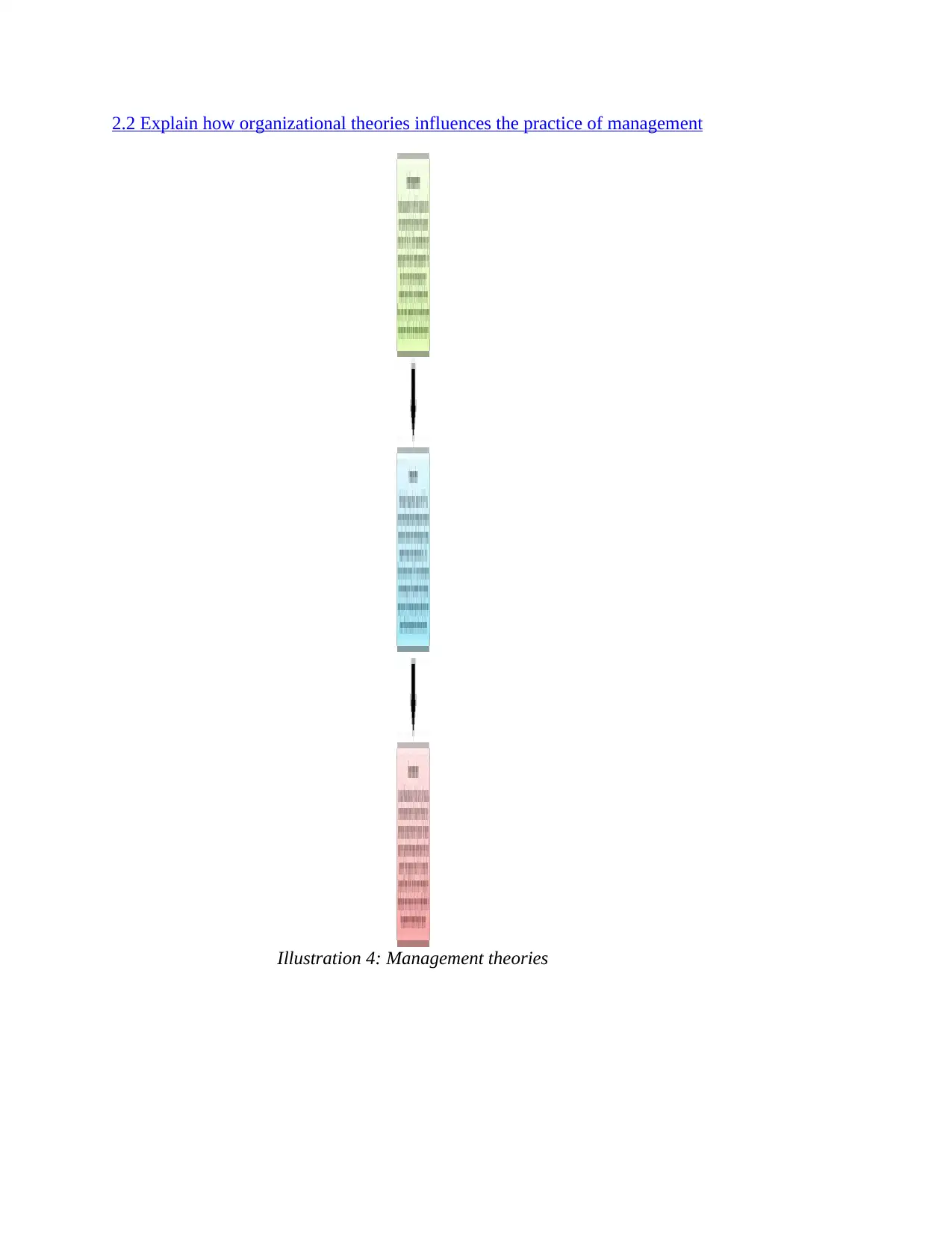
2.2 Explain how organizational theories influences the practice of management
Illustration 4: Management theories
Illustration 4: Management theories
Paraphrase This Document
Need a fresh take? Get an instant paraphrase of this document with our AI Paraphraser
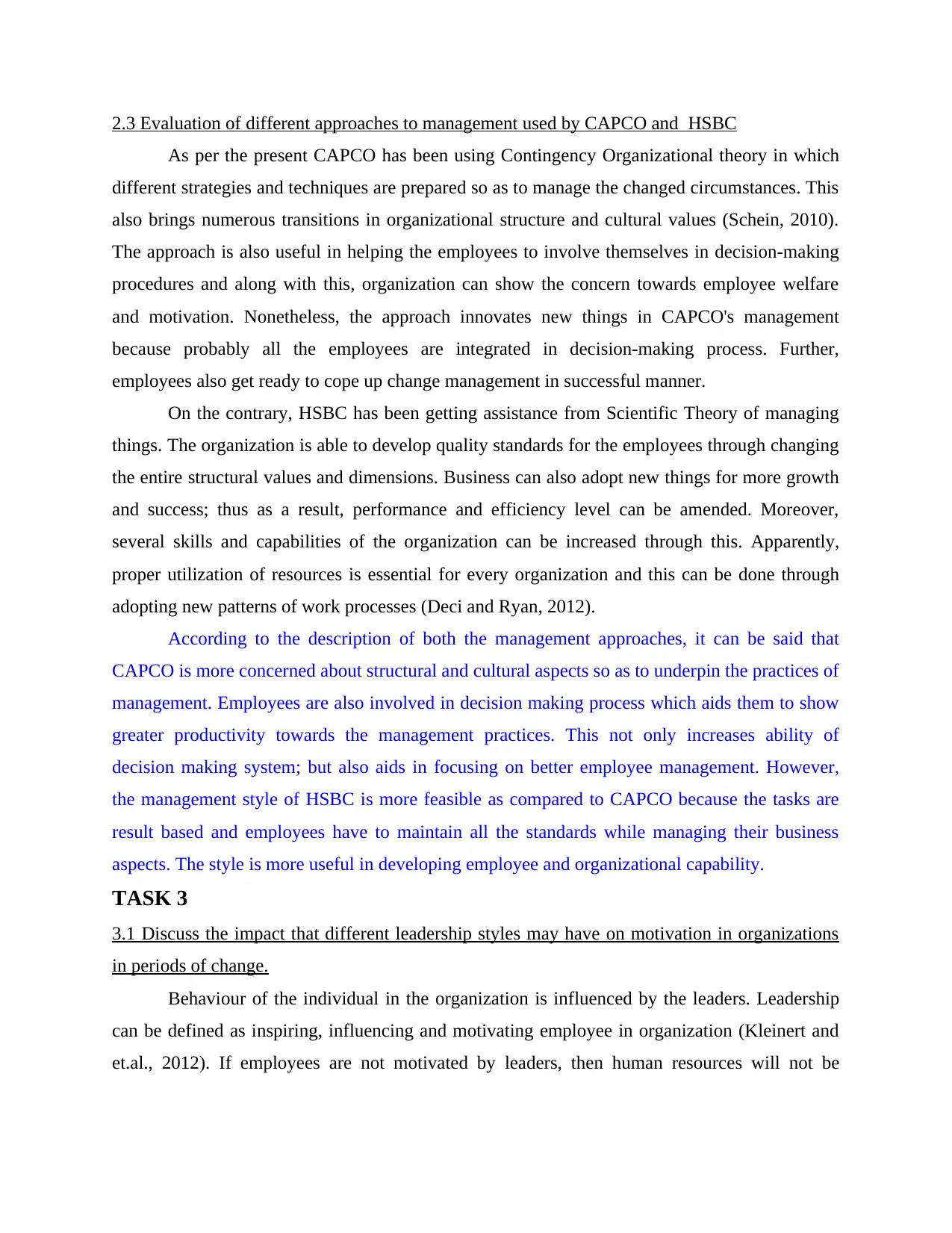
2.3 Evaluation of different approaches to management used by CAPCO and HSBC
As per the present CAPCO has been using Contingency Organizational theory in which
different strategies and techniques are prepared so as to manage the changed circumstances. This
also brings numerous transitions in organizational structure and cultural values (Schein, 2010).
The approach is also useful in helping the employees to involve themselves in decision-making
procedures and along with this, organization can show the concern towards employee welfare
and motivation. Nonetheless, the approach innovates new things in CAPCO's management
because probably all the employees are integrated in decision-making process. Further,
employees also get ready to cope up change management in successful manner.
On the contrary, HSBC has been getting assistance from Scientific Theory of managing
things. The organization is able to develop quality standards for the employees through changing
the entire structural values and dimensions. Business can also adopt new things for more growth
and success; thus as a result, performance and efficiency level can be amended. Moreover,
several skills and capabilities of the organization can be increased through this. Apparently,
proper utilization of resources is essential for every organization and this can be done through
adopting new patterns of work processes (Deci and Ryan, 2012).
According to the description of both the management approaches, it can be said that
CAPCO is more concerned about structural and cultural aspects so as to underpin the practices of
management. Employees are also involved in decision making process which aids them to show
greater productivity towards the management practices. This not only increases ability of
decision making system; but also aids in focusing on better employee management. However,
the management style of HSBC is more feasible as compared to CAPCO because the tasks are
result based and employees have to maintain all the standards while managing their business
aspects. The style is more useful in developing employee and organizational capability.
TASK 3
3.1 Discuss the impact that different leadership styles may have on motivation in organizations
in periods of change.
Behaviour of the individual in the organization is influenced by the leaders. Leadership
can be defined as inspiring, influencing and motivating employee in organization (Kleinert and
et.al., 2012). If employees are not motivated by leaders, then human resources will not be
As per the present CAPCO has been using Contingency Organizational theory in which
different strategies and techniques are prepared so as to manage the changed circumstances. This
also brings numerous transitions in organizational structure and cultural values (Schein, 2010).
The approach is also useful in helping the employees to involve themselves in decision-making
procedures and along with this, organization can show the concern towards employee welfare
and motivation. Nonetheless, the approach innovates new things in CAPCO's management
because probably all the employees are integrated in decision-making process. Further,
employees also get ready to cope up change management in successful manner.
On the contrary, HSBC has been getting assistance from Scientific Theory of managing
things. The organization is able to develop quality standards for the employees through changing
the entire structural values and dimensions. Business can also adopt new things for more growth
and success; thus as a result, performance and efficiency level can be amended. Moreover,
several skills and capabilities of the organization can be increased through this. Apparently,
proper utilization of resources is essential for every organization and this can be done through
adopting new patterns of work processes (Deci and Ryan, 2012).
According to the description of both the management approaches, it can be said that
CAPCO is more concerned about structural and cultural aspects so as to underpin the practices of
management. Employees are also involved in decision making process which aids them to show
greater productivity towards the management practices. This not only increases ability of
decision making system; but also aids in focusing on better employee management. However,
the management style of HSBC is more feasible as compared to CAPCO because the tasks are
result based and employees have to maintain all the standards while managing their business
aspects. The style is more useful in developing employee and organizational capability.
TASK 3
3.1 Discuss the impact that different leadership styles may have on motivation in organizations
in periods of change.
Behaviour of the individual in the organization is influenced by the leaders. Leadership
can be defined as inspiring, influencing and motivating employee in organization (Kleinert and
et.al., 2012). If employees are not motivated by leaders, then human resources will not be
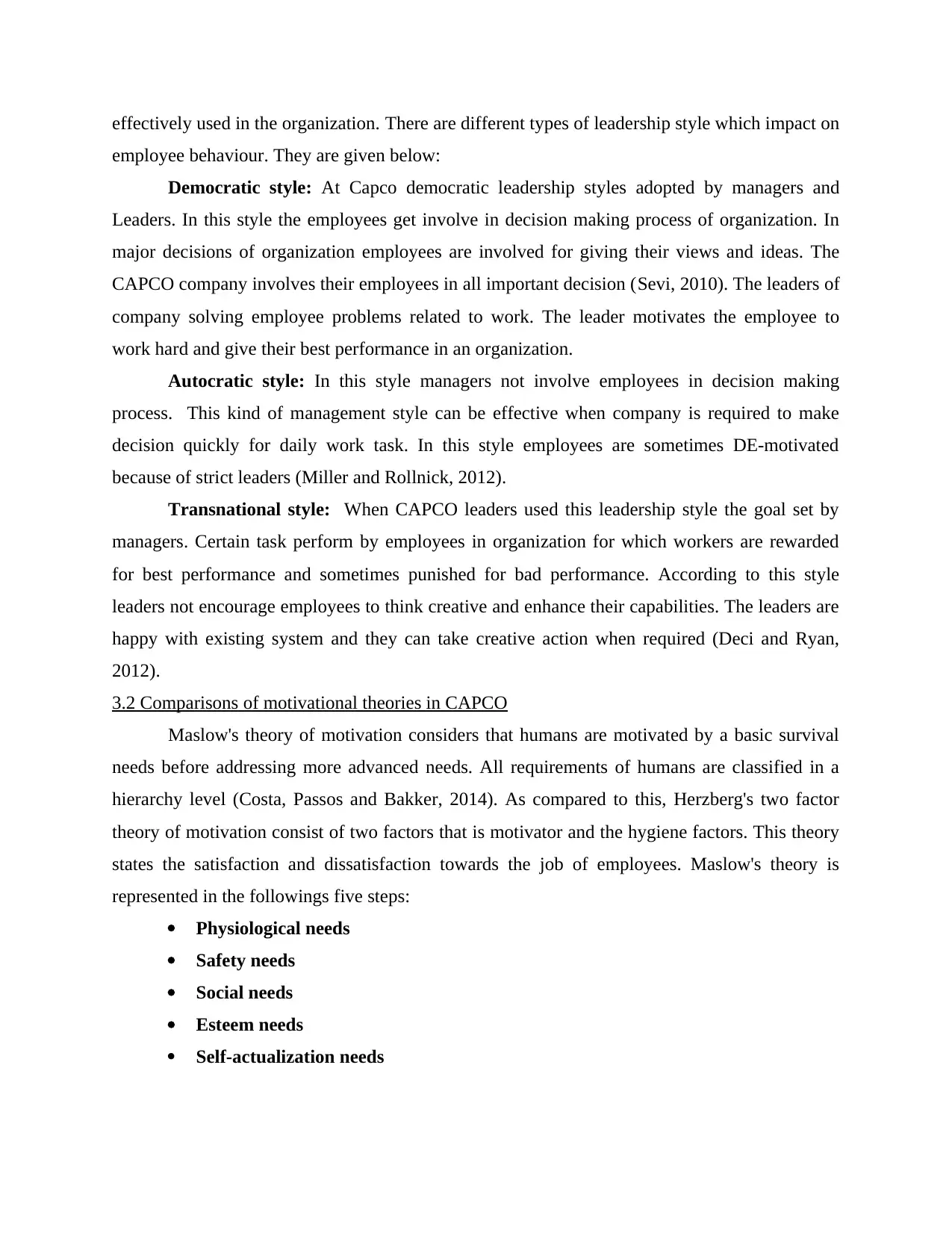
effectively used in the organization. There are different types of leadership style which impact on
employee behaviour. They are given below:
Democratic style: At Capco democratic leadership styles adopted by managers and
Leaders. In this style the employees get involve in decision making process of organization. In
major decisions of organization employees are involved for giving their views and ideas. The
CAPCO company involves their employees in all important decision (Sevi, 2010). The leaders of
company solving employee problems related to work. The leader motivates the employee to
work hard and give their best performance in an organization.
Autocratic style: In this style managers not involve employees in decision making
process. This kind of management style can be effective when company is required to make
decision quickly for daily work task. In this style employees are sometimes DE-motivated
because of strict leaders (Miller and Rollnick, 2012).
Transnational style: When CAPCO leaders used this leadership style the goal set by
managers. Certain task perform by employees in organization for which workers are rewarded
for best performance and sometimes punished for bad performance. According to this style
leaders not encourage employees to think creative and enhance their capabilities. The leaders are
happy with existing system and they can take creative action when required (Deci and Ryan,
2012).
3.2 Comparisons of motivational theories in CAPCO
Maslow's theory of motivation considers that humans are motivated by a basic survival
needs before addressing more advanced needs. All requirements of humans are classified in a
hierarchy level (Costa, Passos and Bakker, 2014). As compared to this, Herzberg's two factor
theory of motivation consist of two factors that is motivator and the hygiene factors. This theory
states the satisfaction and dissatisfaction towards the job of employees. Maslow's theory is
represented in the followings five steps:
Physiological needs
Safety needs
Social needs
Esteem needs
Self-actualization needs
employee behaviour. They are given below:
Democratic style: At Capco democratic leadership styles adopted by managers and
Leaders. In this style the employees get involve in decision making process of organization. In
major decisions of organization employees are involved for giving their views and ideas. The
CAPCO company involves their employees in all important decision (Sevi, 2010). The leaders of
company solving employee problems related to work. The leader motivates the employee to
work hard and give their best performance in an organization.
Autocratic style: In this style managers not involve employees in decision making
process. This kind of management style can be effective when company is required to make
decision quickly for daily work task. In this style employees are sometimes DE-motivated
because of strict leaders (Miller and Rollnick, 2012).
Transnational style: When CAPCO leaders used this leadership style the goal set by
managers. Certain task perform by employees in organization for which workers are rewarded
for best performance and sometimes punished for bad performance. According to this style
leaders not encourage employees to think creative and enhance their capabilities. The leaders are
happy with existing system and they can take creative action when required (Deci and Ryan,
2012).
3.2 Comparisons of motivational theories in CAPCO
Maslow's theory of motivation considers that humans are motivated by a basic survival
needs before addressing more advanced needs. All requirements of humans are classified in a
hierarchy level (Costa, Passos and Bakker, 2014). As compared to this, Herzberg's two factor
theory of motivation consist of two factors that is motivator and the hygiene factors. This theory
states the satisfaction and dissatisfaction towards the job of employees. Maslow's theory is
represented in the followings five steps:
Physiological needs
Safety needs
Social needs
Esteem needs
Self-actualization needs
⊘ This is a preview!⊘
Do you want full access?
Subscribe today to unlock all pages.

Trusted by 1+ million students worldwide
1 out of 23
Related Documents
Your All-in-One AI-Powered Toolkit for Academic Success.
+13062052269
info@desklib.com
Available 24*7 on WhatsApp / Email
![[object Object]](/_next/static/media/star-bottom.7253800d.svg)
Unlock your academic potential
Copyright © 2020–2025 A2Z Services. All Rights Reserved. Developed and managed by ZUCOL.





